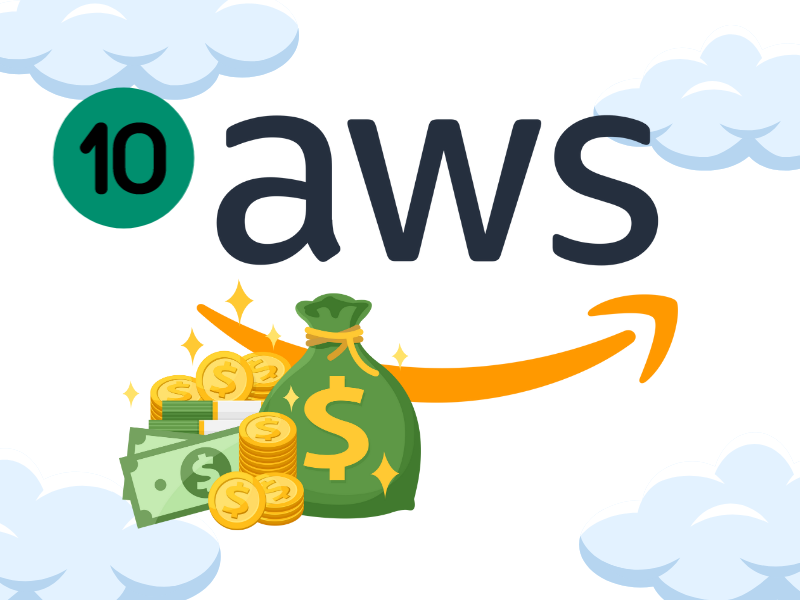As an increasing number of businesses are migrating to the cloud, managing costs becomes a critical aspect of their AWS (Amazon Web Services) journey. With the vast array of services and configurations available, it can be easy to overspend if cost optimization strategies are not effectively implemented.
The subsequent sections explore the top 10 essential strategies to help optimize AWS budgets and drive better ROI for cloud infrastructure.
Contents
- Strategy 1: Right-sizing and Resource Management
- Strategy 2: Leveraging AWS Pricing Models
- Strategy 3: Effective Data Storage Choices
- Strategy 4: Monitoring and Cost Visibility
- Strategy 5: Optimal Network Design
- Strategy 6: Containerization and Serverless Architectures
- Strategy 7: Cost-Aware Application Design
- Strategy 8: Optimizing Database Costs
- Strategy 9: Governance and Cost Accountability
- Strategy 10: Continuous Cost Optimization
- Conclusion
- About TrackIt
Strategy 1: Right-sizing and Resource Management

Understanding instance types and families
Selecting the right instance type for workloads is crucial. AWS provides a range of instance families for each service, and each is designed for specific use cases. Analyzing the specific requirements of applications and matching them with the appropriate instance type can result in significant cost savings.
Utilizing AWS Cost Explorer for resource analysis
AWS Cost Explorer offers valuable insight into usage patterns, this assists in identifying areas where resources are underutilized or overprovisioned. By analyzing resource data, infrastructure can be optimized and unnecessary expenses eliminated.
Implementing AWS Auto Scaling to match demand
Dynamic workloads often lead to fluctuating resource needs. AWS Auto Scaling automatically adjusts the resource capacity based on demand and ensures optimal performance while minimizing costs during periods of lower activity.
Identifying and eliminating idle resources
Regular reviews of AWS infrastructure help identify idle resources such as instances, volumes, or databases that are no longer in use. Removing these idle resources can result in immediate cost reductions.
Strategy 2: Leveraging AWS Pricing Models
On-Demand Instances vs. Reserved Instances
Carefully evaluating workload characteristics assists in determining the most cost-effective pricing model for the services used. For example, On-Demand EC2 instances provide flexibility but may not be the most cost-effective choice for stable and predictable workloads. Reserved Instances, on the other hand, offer substantial discounts for 1-year or 3-year terms, making them an ideal choice for unchanging workloads.
Savings Plans and their benefits
Savings Plans offer flexibility similar to On-Demand Instances, with up to 72% in cost savings compared to regular On-Demand rates. Understanding long-term resource needs and committing to Savings Plans can lead to substantial cost reductions.
Spot Instances for cost-efficient workloads
EC2 Spot Instances provide access to spare compute capacity at significantly reduced prices. Leveraging Spot Instances for non-critical, fault-tolerant workloads can lead to considerable cost optimization. However, it is important to keep in mind that these instances can be terminated if and when AWS needs the capacity back.
Strategy 3: Effective Data Storage Choices
Evaluating and choosing suitable storage options
AWS offers multiple storage services catering to different use cases and access patterns. Understanding the strengths and limitations of services such as Amazon S3, Amazon EBS, and Amazon S3 Glacier can assist in selecting the most appropriate and cost-effective storage solution for data and storage workflows.
Lifecycle policies for data archiving and cost reduction
Implementing lifecycle policies helps to automatically move infrequently accessed data to lower-cost storage tiers or archives. This approach optimizes storage costs without compromising data availability.
Automating Data Migrations
Tools such as AWS DataSync can be used to automate and accelerate the movement of data between on-premises and AWS storage services. DataSync serves as a secure means to simplify and streamline the movement of data between multiple storage systems in a cost-effective manner.
Strategy 4: Monitoring and Cost Visibility
Using AWS Cost Explorer for cost breakdowns
AWS Cost Explorer provides detailed cost reports and visualizations, enabling the analysis of spending patterns across different services and accounts. This visibility is essential for identifying cost drivers and opportunities for optimization.
Setting up billing alerts to control spending
Billing alerts can be configured to receive notifications when costs approach predefined thresholds. Timely alerts help take corrective actions before costs spiral out of control.
Leveraging AWS Trusted Advisor for cost recommendations
AWS Trusted Advisor provides real-time guidance on cost optimization, security, and performance. Leveraging its recommendations can help fine-tune AWS infrastructure for cost efficiency.
Strategy 5: Optimal Network Design
Analyzing data transfer costs between regions and availability zones
Data transfer costs can quickly add up, especially when transferring data across different AWS regions or availability zones. Optimizing network infrastructure design helps minimize and mitigate unnecessary costs.
Leveraging Amazon CloudFront for caching and reduced latency
Amazon CloudFront, AWS’s Content Delivery Network (CDN) can be utilized to cache and deliver content from edge locations which are closer to users, reducing data transfer costs and improving performance. The dispersed infrastructure of CloudFront helps to securely and cost-effectively deliver content to a geographically dispersed audiences at high transfer speeds.
Employing Amazon VPC peering and transit gateways efficiently
Optimizing network connections between virtual private clouds (VPC) can help ensure cost-effective communication between VPCs. VPC Peering connections and AWS Transit Gateways can be used to streamline and simplify VPC connectivity.
Strategy 6: Containerization and Serverless Architectures
Embracing serverless computing for reduced operational costs
Serverless architectures eliminate the need to manage and provision servers, offering a more cost-efficient way to run applications. Leveraging serverless AWS services such as AWS Lambda and AWS Step Functions helps build solutions that can scale seamlessly to accommodate fluctuating demands while minimizing costs.
Implementing containers with Amazon ECS or EKS for resource efficiency
Containers help enhance portability, optimize resource usage, and ensure consistent performance. Amazon Elastic Container Service (ECS) and Amazon Elastic Kubernetes Service (EKS) offer managed container solutions that optimize resource utilization and minimize costs.
Strategy 7: Cost-Aware Application Design
Designing applications for elasticity and scalability
Applications utilizing services that can scale both vertically and horizontally based on demand offer maximum flexibility from a cost standpoint. Elastic applications efficiently utilize resources, minimizing costs during periods of lower usage.
Event-driven and cost-efficient functions
AWS Lambda and AWS Step Functions can be leveraged to implement large-scale event-driven applications. As discussed earlier, these serverless services only incur costs when they are triggered and actively running, making them highly cost-efficient solutions for event-driven architectures.
Utilizing caching mechanisms
Utilizing caching mechanisms like Amazon Elasticache or Amazon DynamoDB Accelerator (DAX) can help reduce the need for repeated and resource-intensive data retrievals, leading to significant cost optimization. By storing frequently accessed data in-memory with low-latency access, caching solutions minimize the number of requests made to the underlying data sources, thereby reducing data processing costs.
Strategy 8: Optimizing Database Costs
Evaluating workload requirements
Analyzing the performance and resource needs of database workloads helps select the right database instance type and size based on workload characteristics. Choosing the right database instance can prevent overprovisioning, and reduce unnecessary costs.
Leveraging AWS RDS Reserved Instances
For long-term, stable database workloads, utilizing Reserved Instances for Amazon RDS (Relational Database Service) can lead to substantial cost savings. Reserved Instances can help save up to 69% over on-demand rates when used in a steady state.
Utilizing Multi-AZ deployments wisely
Multi-AZ (Availability Zone) deployments enhance database availability and durability but come with increased costs. For non-critical workloads, Single-AZ deployments can be utilized to reduce expenses.
Strategy 9: Governance and Cost Accountability
Implementing AWS IAM for cost control
AWS Identity and Access Management (IAM) provides fine-grained control over user permissions, helping limit user access to AWS resources and reduce the risk of unauthorized spending.
Utilizing AWS Organizations to manage multiple accounts centrally
AWS Organizations helps to manage multiple AWS accounts and apply cost control policies consistently across all accounts, optimizing costs and ensuring financial accountability. AWS Organizations also allow for consolidated billing, costs incurred across different accounts are aggregated into a single bill. This simplifies the financial management process and provides a clear overview of the overall AWS spending for the entire organization.
Utilizing cost allocation tags to categorize AWS resources helps associate costs with specific projects or departments. By ensuring better visibility for cloud spending,cost allocation tags facilitate a culture of accountability by attributing cloud expenses to specific entities within the organization.This encourages ownership of cloud resource usage and their impact on the overall AWS budget
Strategy 10: Continuous Cost Optimization
Building a culture of cost optimization within the organization
Making cost optimization a shared responsibility across teams and departments helps ensure continuous cost-conscious decision-making. Encouraging and incentivizing innovation in cost optimization by recognizing and rewarding individuals or teams who devise creative and impactful cost-saving initiatives helps embed cost optimization into the fabric of the organization.
Conducting periodic infrastructure reviews
Reviewing and optimizing AWS infrastructure is essential to ensure that cost-saving measures remain effective and relevant over time. As business needs evolve, technology advancements occur, and AWS introduces new services or pricing models. Conducting periodic reviews helps stay up-to-date with cost optimization opportunities.
Leveraging AWS partner expertise for cost optimization insights
Engaging with AWS partners for cost optimization insights can be highly advantageous as these partners possess in-depth knowledge of AWS services, architecture best practices, and real-world experience in optimizing cloud costs. They can provide tailored guidance based on an organization’s unique use cases and requirements, and help to identify cost-saving opportunities that may not be immediately apparent.
Conclusion
Optimizing costs on AWS is an ongoing journey that requires proactive planning, monitoring, and adaptation. By implementing the ten cost optimization strategies outlined in this article, businesses can make the most of their AWS budget, achieving greater efficiency, and maximizing their cloud investment. By prioritizing cost optimization and fostering a culture of fiscal responsibility, organizations can confidently navigate the AWS ecosystem while driving growth and innovation.
About TrackIt
TrackIt is an international AWS cloud consulting, systems integration, and software development firm headquartered in Marina del Rey, CA.
We have built our reputation on helping media companies architect and implement cost-effective, reliable, and scalable Media & Entertainment workflows in the cloud. These include streaming and on-demand video solutions, media asset management, and archiving, incorporating the latest AI technology to build bespoke media solutions tailored to customer requirements.
Cloud-native software development is at the foundation of what we do. We specialize in Application Modernization, Containerization, Infrastructure as Code and event-driven serverless architectures by leveraging the latest AWS services. Along with our Managed Services offerings which provide 24/7 cloud infrastructure maintenance and support, we are able to provide complete solutions for the media industry.

